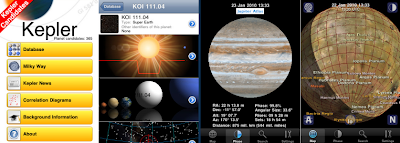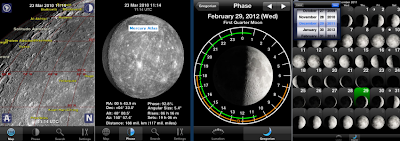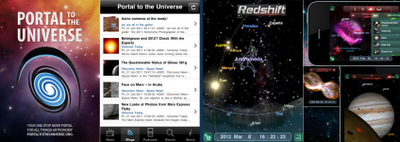I downloaded a new space app to my phone and thought, HEY! Wouldn't it be cool if I had a list of every mobile space application I could find for hand-held devices?
I should learn to just slap myself in the head when such thoughts occur, and move on with my life. But no, I tried to find a list, finding only a few that were hideously out-dated, and then proceeded to comb both Apple and Android directories for every app with or involving: astronomical clocks, space mission, space agencies, eclipse simulators, orreries, rover driver sims, planet maps, moon phase calendars, astronomy dictionaries, and interactive solar systems.
Figured I'd find 30-40 apps. Nope, got 102 and still counting! Adding more as I find them tucked away in every corner of the internet, and I welcome any mention from readers of once I have missed, or your experience with any already listed.
Most are designed for iPhones, though many are compatible with iPad/iTouch. Those with pink text and asterisks* are specifically for Android. Click on each to see their creators, platforms, full descriptions and reviews... and note that a more formally tabled version of this guide is also available on pillownaut.com.
FREE! Aquarius (NASA)
Aquarius/SAC-D observatory mission by NASA and space agency of Argentina to study ocean salinity, freshwater paths and other factors affecting Earth's climate.
FREE! Ascent: Shuttle (NASA)
Commemorative video of STS-114, 117, and 124 Shuttle missions, including entire Ascent production with commentary, images, etc.
FREE! AstroApp: Space Shuttle Crew (NASA)
Every space traveler who flew on every Space Shuttle in the 30-year program, 1981 - 2011, sorted by name or by mission.
FREE! AstroApp: Space Station Crew (NASA)
17 partner countries support science in low Earth orbit aboard the ISS; every space traveler who flew on every expedition, sorted by name or mission.
$1.99 Astrock
Astronomical Clock: real-time sky map, daylight awareness, planet positions.
$0.99 AstroGizmo
88 modern constellations, planets, moon and all stars visible to the naked eye.
$14.99 Astromist
The largest pocket astronomer, available on multiple platforms, with nearly 20,000 images in huge libraries! Telescope control, Moon calendar, and Earth satellites simulator. Also: Mars, Jupiter, Comet & Asteroid assistants.
$9.99 Astromo
Orrery, Armillary, Ephemeris: see where in the zodiac the Sun, Moon and visible planets are, sunrise/sunset times.
$2.99 Astronomy Picture of the Day Viewer
POTD facts and wallpapers.
FREE! Astronomy Picture of the Day Lite
Slightly fewer POTD facts and wallpapers.
$0.99 Astronomy WhereIsIt *
Celestial objects, star refs, messier objects, horizon coordinates, etc.

FREE! Astro Planner Lite
Astronomical deep sky objects like galaxies, nebulas and star clusters, plus link to NASA's Sky View servers.
FREE! AstroTools *
Hand-held Planetarium for the amateur astronomer, nice one for beginners.
FREE! Best of Astronomy *
Scientific information, videos and books on any astronomy topic with features to make and share reports on origin of universe, solar system, galaxies, black holes, big bang theory, famous scientists, etc.
FREE! Cassini (NASA)
Mission launched in 1997 exploring Planet Saturn and its moons; orbits, flybys, study data, news updates, maneuver.
FREE! CometQuest (NASA)
Land the Rosetta spacecraft on the comet 67P/Churyumov-Gerasimenko and record surface craters and cracks, water or gas jets erupting, rock and ice of the bright tail, etc.
FREE! CosmoCalc
Set a reference cosmology and redshift to calculate astronomical distances and size scales.
FREE! CraterSizeXL
Calculates predicted results of asteroid impact event on various planets.
Yeah, gee, that's not morbid at all.
FREE! Daily Astronomy *
Displays NASA's astronomy photo of the day except when there's a video.
$5.49 Deep Sky Browser
Access to the Digital Sky Survey with 45,000+ celestial objects.
$9.99 Distant Suns
Night Sky Network Star-gazing, star data, constellation labels, etc.
FREE! DLR - German Aerospace Center
Deutsches Zentrum für Luft- und Raumfahrt e.V's online magazine, missions and activities.
 FREE! Earth Now (NASA)
FREE! Earth Now (NASA)3D models of global climate data from Earth Science satellites: air temps, carbon dioxide & monoxide, ozone, water vapor, gravity and sea level variations.
$0.99 Emerald Observatory
Astronomical clocks, orrery, star charts, moon phases, eclipse simulator, etc.
FREE! ESA OSHI
European Space Agency Online Showcase of Herschel Images; Hershel Space Observatory carries the most powerful infrared telescope ever flown in space.
FREE! ESO TOP 100
European Southern Observatory images, music and descriptions from the world's most advanced ground telescopes in Chile.
FREE! Exoplanet
Database of all extrasolar planets discovered by the NASA Kepler mission.
FREE Fermi Sky
Fermi gamma-ray space telescope images, supermassive black holes, merging neutron stars, etc.
$0.99 Galaxy Collider
Graphical simulator for physics of interacting and/or colliding galaxies.
FREE! Galaxy Zoo
Help astronomers classify galaxies from the Sloan Digital Sky Survey according to shape and other properties.
FREE! Google Sky Map *
Android window on the night sky, showing constellations, planets and stars.

$9.99 GoSatWatch
Real-time earth-orbit satellite tracking, including the International Space Station (ISS).
$3.99 GoSkyWatch Planetarium
Point to the sky with your device to use as a personal telescope to locate stars, planets, constellations, galaxies.
FREE! Go StarGaze
Astronomical Society of the Pacific, the largest general astronomy society in the world, helps find stargazing events and astronomy clubs.
FREE! GRAIL (NASA)
Gravity And Interior Laboratory twin probes now circling Earth's moon.
FREE! GravLens
Gravitational lensing astrophysical phenomenon, where light of a distant galaxy is bent by a massive foreground galaxy.
FREE! HubbleSite
Space Telescope Science Institute presents a gallery of Hubble Space Telescope wallpapers and descriptions.
FREE! Hubble Space Telescope *
Planets, stars, nebulae, galaxies as catalogued by Edwin Hubble's namesake.
FREE! Hubble Top 100
European Southern Observatory Hubble gallery, set to music, with descriptions.

$0.99 iMoonU
Moon phases calendars for any date, past, present or future; also, countdown clock for full moons.
FREE! Invisible Universe *
Point your device at the sky and see the non-visible ranges as opposed to visible! Rare!
$0.99 ISolarScape
Location-based observatory for sun, moon, planets, asteroids and NASA missions.
FREE! iSpaceNews
NASA and ESA history, media, news and images.
FREE! ISS CDR
International Space Station on-orbit status, tasks, news, arrivals, and departures.
$8.99 iStellar
HUGE Planisphere 1900-2099 with planets, stars that twinkle, constellations, eclipse sims, meteor showers, comet paths, Milky Way map, etc.
$2.99 Jupiter Atlas
3-D Globe images of planet Jupiter and the four Galilean Moons: Ganymede, Callisto, Europa, and Io.
$2.99 Kepler
Professional astronomer-updated exoplanet database from NASA's Kepler mission, plus Milky Way map and correlation diagrams.

$0.99 Living Earth HD
3-D Earth globe with weather satellite updates, world clock, sunrise/sunset times, etc. GORGEOUS IMAGERY!!
$0.99 Lúan
Lúan is an Old Irish Gaelic name for the moon; app shows Lunation tables per time zone, animated lunar transitions, moon and sun rising and setting times, etc.
$3.99 Luminous
Planisphere and simulator, with data on celestial objects. Can be set up to match your sky or to show you the sky from any date or location.
FREE! Lunar Electric Rover Simulator (NASA)
Drive on the moon! Support the activities of a functioning Lunar Outpost, using multiple difficulty levels in the most recently developed LER.
$5.99 Mars Atlas
3-D globe of planet Mars with zoomable terrain and labels.
FREE! Mars Globe
High-resolution satellite maps of Mars with labels; aerial terrain, and also views from various Rovers.
$2.99 Mercury Atlas
3-D globe of planet Mercury with zoomable terrain and labels.
FREE! Messier List
Images, data and positions of French Astronomer / Comet-Hunter Charles Messier's famed list of nebulae, clusters, galaxies, etc.

$3.99 Mobile Observatory *
Planisphere with point & view function for any location or date/time; solar system views, eclipses, sun rise & set times, moon phases, constellations, etc.
FREE! Moon
Lunar phases, moonrises and sets, azimuth and altitude, and distance for current or or any other date.
$5.99 Moon Atlas
3-D globe of Earth's Moon satellite with zoomable terrain and labels.
FREE! Moon Globe
3-D views of the moon with labels and surface features from satellite imagery.
$1.99 MoonLight
Lunar phases for any date, views of the moon from any location on Earth.
$0.99 Moon Phase Pro *
Lunar phases on a 3-D globe for any date, plus moon-phases calendar, syzygies, rises & sets, etc.
FREE! NASA For Android *
Official NASA space agency App for Android.
FREE! NASA For iPhone
Official NASA space agency App for iPhone (and iPod Touch).
FREE! NASA Be A Martian
Mars maps, images, news, missions, Q&A for learning, alien avatars, etc. Open source project based on beamartian.jpl.nasa.gov.

FREE! NASA Image Archive for Android *
60k+ space agency images in five categories: Universe, Solar System, Earth, Aeronautics, Astronauts.
FREE! NASA Now
Regularly updated NASA news-feed the NASA Image Of The Day, and the latest from various NASA missions.
FREE!NASA Space Weather Media Viewer
Near real-time imagery from NASA missions, scientist interviews about space phenomena, and NASA-created space visualizations.
FREE! NASA Television
Live or on-demand TV programming from The NASA channel.
$1.99 Night Sketch
Basic planisphere showing the sky above your device, where you can connect stars to create and share constellations.
$14.99 Oxford Astronomy
The entire massive Oxford Dictionary of Astronomy: 4000+ entries on all aspects of galaxies compiled by 20+ experts.
FREE! Orbit Architect
Change parameters of satellite orbits and then see animation of results; also, real-time ground tracking of sats.
$1.99 PlanetFacts Plus
Catalog of images and information about the bodies in the solar system, including dwarf planets, with maps to show scale.

FREE! Planets
Planishere Sky 2-D and 3-D switchable program which shows the location and orbital paths of planets, Sun & Moon with visibility information for your location. Constellations in the backdrop.
$0.99 Planisphere
Shows zoomable sky above the phone or for any location; shows rise & set times, and star constellations.
$2.99 Pocket Universe: Virtual Sky Astronomy
Planisphere with constellation outlines, lunar phases, planets in the solar system, moons of Jupiter and Saturn, with Q&A function.
FREE! Portal To The Universe
Magazine style consolidator web site organized by ESO/IAU/ESA, showing scientific breakthroughs, news and space blog posts from the worlds observatories, agencies and educational institutions.
$11.99 Redshift-Astronomy
Most sophisticated planisphere available, showing the sky above your device, 3-D solar system, massive catalog of stars and celestial objects; also, deep space objects and scale flights to / around them.
FREE! Satellite Insight (NASA)
Critical real-time weather data from the GOES-R weather satellite in a game.
$0.99 Satellites
NORAD and NASA tracking of the International Space Station (ISS) and other orbiting hardware.
$2.99 Saturn Atlas
3-D globe of planet Saturn and its 7 largest moons, with surface features.
$0.99 Sky Master
Solar System simulator and planetarium of the sky at any time/date, based on your Earth location; planets, stars, constellations and galaxies.

$4.99 SkyQ
Planisphere and multimedia sky guide from telescope manufacturer; audio tours, moon phases, planet & satellite positions, etc.
FREE! SkyOrb
3-D star map, 3D planetarium, ephemeris, search engine, solar clock, etc.
FREE! Sky Safari *
Planisphere showing sky above your device, catalog of thousands of celestial objects and renderings.
$1.99 SkyView - Explore the Universe
Planisphere showing objects and descriptions based on device point; artificial satellite paths, 3D graphics, etc.
FREE! Solar Dynamics Observatory (NASA) *
Video and high-resolution images of the Sun, solar atmosphere, and its affect on near-Earth objects from the NASA SDO satellite.
$0.99 Solar Max *
Latest Hi-Res images from the NASA/ESA Solar and Heliospheric Observatory (SoHO) satellite.
$2.99 Solar Walk
3D Dynamic Solar System model you can fly through at any date, with movie mode and music (3-D TV option if you have 3-D glasses).
FREE! Space Images for Android (NASA) *
Hundreds of images taken by NASA spacecraft studying planets, stars, galaxies, weather on Earth and more.
FREE! Space Images for iPhone (NASA)
Hundreds of images taken by NASA spacecraft studying planets, stars, galaxies, weather on Earth and more.
$4.99 Space Junk *
Based on your location, shows Earth view, planets, constellations and will track the Hubble Space Telescope, International Space Station, hundreds of satellites, etc.

FREE! Star & Planet Finder
Select a celestial object such as a star or planet, and app will help you find it using a pointer.
$2.99 Star Chart *
Based on your location, Planisphere app shows constellations, Moon, planets, etc.
$3.99 Star Charts
Not for beginners! 18 extremely detailed charts based on atlas by famed celestial cartographer Wil Tirion.
$1.99 StarMap 3D
Star atlas program for that shows the sky for your location and gives information for selected planets, stars, constellations, star clusters, galaxies, and nebulae.
$11.99 Star Map
High-quality Planisphere show sky above device at any time; 350k+ catalogued stars, and advice for astronomers on best viewing locations, landscapes + horizon profiles, and observation conditions, such as weather, moonlight and possible sources of city light pollution; also calendars, animation, night vision mode, etc.
$0.99 Star Rover
Planisphere app with point & view function for stars, moon phases, planets, etc.
$2.99 Star Walk
Point and view planesphere which also includes satellite tracking, calendar, moon phases, plus the Astronomy Picture of the Day.
FREE! Stellarium
Mobile version of the popular open-source planisphere program with constellation views and detailed professional data.

$2.99 SunDroid Pro *
Calculates path of Sun & Moon, all rises and sets, twilights, golden hours, etc.for any date, anywhere in the world.
FREE! Swift Explorer
Swift Mission Operations Center at Penn State University shows NASA's search for gamma-ray bursts.
$2.99 Terra Time *
Real-time interactive Earth globe, showing day/night, weather via satellite data, seasons, lunar phases, twilight times, etc.
FREE! 3D Sun
Sun model based on NASA's STEREO spacecraft images with alerts for major updates or events such as solar flares.
$2.99 Venus Atlas
3-D globe of Venus with 2000+ surface features; also shows the phase of Venus from your location.
$0.99 What's Up
Basic beginner app that shows location of Sun, Moon, and planets in the sky.
FREE! Where Is Io *
Current positions of the Galilean moons, rise and set times for planets, and information about solar system objects.
$4.99 Wolfram Astronomy Course Assistant
Facts, formulas, and tools for helping with introductory astronomy;includes high-res diagrams with 100k stars, sky phenomena, Drake equation data, etc.
$4.33 Zenith Mobile Telescope *
Watch hundreds of stars, constellations, and solar system planets. Also, images of galaxies and nebulae from the Hubble Space Telescope.
This list is also on the Pillownaut domain in a more structured format than I am able to accomplish on blogger.com, and when printed, will generally yield about 12 pages. So for heaven's sake, don't print it. ;)




















